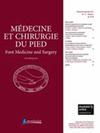Posterior Tibial Tendon and Spring Ligament Lesions in Rheumatoid Arthritis
引用次数: 0
Abstract
In rheumatoid arthritis, a significant number of patients have hindfoot pain while they are considered in low disease activity. Then the rheumatoid hindfoot may evolve in valgus flat foot with disability. The aim of our study was to observe the lesions of the main stabilizers of the hindfoot in rheumatoid arthritis to improve the followup and the treatment of the disease. Thirty-three feet (from 21 patients) with rheumatoid arthritis and pain of the hindfoot were consecutively observed. The patients have had no biologic treatment. Every foot had Magnetic Resonance Imaging (MRI) of the hindfoot with gadolinium injection. The tendon of the tibialis posterior muscle, the spring ligament and the inter-osseous talocalcaneal ligament were considered. All the feet presented tenosynovitis of the posterior tibial tendon. Structural lesions of the posterior tibial tendon (23/33 feet, 69.7%) were more frequent than lesions of the spring ligament (12/33 feet, 36.4%). There was no inferior spring ligament lesion without superior spring ligament lesion. No interosseous talocalcaneal ligament lesion was observed. In rheumatoid arthritis, the hindfoot, and particularly the posterior tibial tendon, should be evaluated during patient follow-up to detect a possible lesion. Posterior tibial tendon lesion arises at the same time as the spring ligament lesion, before interosseous talocalcaneal ligament lesion. Imaging, especially MRI, may complete clinical examination. If rheumatoid involvement of the posterior tibial tendon is observed, treatment intensification is required.类风湿性关节炎的胫骨后肌腱和弹簧韧带病变
在类风湿关节炎中,相当多的患者在疾病活动度较低时出现后足疼痛。然后,类风湿性后足可能演变为外翻扁平足残疾。我们的研究目的是观察类风湿关节炎后足主要稳定剂的病变情况,以改善该病的随访和治疗。连续观察33脚(来自21例患者)类风湿关节炎和后足疼痛。患者未接受生物治疗。每只脚均行后脚注射钆的磁共振成像(MRI)。考虑胫骨后肌肌腱、弹簧韧带和距跟骨间韧带。所有足部均表现为胫后肌腱腱鞘炎。胫骨后肌腱的结构性病变(23/33英尺,69.7%)比弹簧韧带的病变(12/33英尺,36.4%)更常见。下弹簧韧带无损伤,上弹簧韧带无损伤。距骨跟骨间韧带未见损伤。在类风湿关节炎中,应在患者随访期间评估后脚,特别是胫骨后腱,以发现可能的病变。胫后肌腱病变与弹簧韧带病变同时出现,先于距跟骨间韧带病变。影像学,尤其是MRI,可以完成临床检查。如果观察到类风湿性关节炎累及胫骨后腱,则需要加强治疗。
本文章由计算机程序翻译,如有差异,请以英文原文为准。
求助全文
约1分钟内获得全文
求助全文
来源期刊

Medecine et Chirurgie Du Pied
医学-整形外科
自引率
0.00%
发文量
0
审稿时长
>12 weeks
期刊介绍:
The journal Médecine et Chirurgie du Pied was founded in 1984 under the impetus of Dr Simon Braun, who was its editor-in-chief until 1997. It is the official organ of the French Society of Medicine and Surgery of the Foot. After 17 years it is entering upon a new existence with a change of publisher. The French Society of medicine and Surgery of the Foot was founded in 1969 by Professor Paul Galmiche. The multidisciplinary nature of this Society does not allow isolation within one own specialty, rather to share ideas in order to understand a pathology as complex as that of the foot. This journal is the organ of expression of all those interested in the food and its pathology, both in France and abroad.
 求助内容:
求助内容: 应助结果提醒方式:
应助结果提醒方式:


